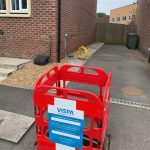Derbyshire UK Ponders Tackling the Final Broadband Slow Spots
Sparse rural communities and new build housing developments are two of the areas that councillors in Derbyshire are now recognising as problems for their on-going Digital Derbyshire (DD) project, which currently aims to ensure that 98% of local premises can access “superfast broadband” (24Mbps+) by the end of 2018.
The local scheme is a joint initiative between Openreach (BT), Derbyshire County Council and the Government’s Broadband Delivery UK programme. So far the £34m deployment has already extended the availability of faster “fibre broadband” (FTTC/P) networks to reach an additional 98,000 premises and thousands more are due to be completed before the end of this year.
As part of this effort some 535 miles of new fibre optic cable has been laid and 487 new street cabinets have been installed, not to mention the 77 exchange areas that were updated to support the new services. Broadly speaking the progress has been good and official figures suggest that they’re close to hitting 96% coverage with superfast connectivity, which hopefully still leaves enough time to hit the 98% target.
Advertisement
Despite this we’ve heard hardly a peep out of the local council(s) for the past two years, which have yet to set out a plan for tackling the final 2% of premises. In theory the area should be able to benefit from several million pounds in public reinvestment, thanks to efficiency savings and clawback clauses in the original contracts.
The good news is that this situation may be about to change, not least since yesterday’s meeting of the South Derbyshire District Council’s Overview and Scrutiny Committee (here), which highlighted the growing problem of new build developments (DD has been using housing records that are 4 years out of date, but many new homes have since been added).
The meeting also noted that around 10 villages and lots of hamlets would be left poorly served by the current scheme.
Rob Rowan, DD Programme Manager, said (Derby Telegraph):
“We get numerous complaints from residents who have moved into a new property, only to find there is no internet connection and all we can say to them is that – by our records – your site is just a field, we don’t have a record of houses there.
There are numerous sites across South Derbyshire which to our records are still just fields.
We would have to do a new review to factor in these houses, but by then the new review would still miss other new houses which would be built.
But all this comes down to whether there is more money in the programme or if more funding can be secured.”
As reported last month (here), most new build home developments that take place today are being equipped with superfast or ultrafast broadband and new proposals from the government could eventually close the remaining gaps. But this is unlikely to do much for the builds that are already underway, many of which went through planning some years ago and have thus skipped more recent policy and planning changes.
Advertisement
At present the council has yet to set out a clear plan for tackling this problem but the important thing is that they have at least woken up to it. In the meantime there’s a suggestion that those affected could consider mixing Openreach’s co-funded Community Fibre Partnerships with grants from the Better Broadband Subsidy Scheme, although the latter is due to end in December.
Equally it’s likely that many of those left poorly served could benefit from the forthcoming Universal Service Obligation (USO), which from 2020 will enable those in slow speed areas to request a broadband speed of at least 10Mbps from supporting ISPs in their area. At the time of writing we’re still waiting for Ofcom to flesh out the details of exactly how the industry will fund this and which ISPs will be assigned responsibility (here).
The issues being raised in Derbyshire are of course by no means unique to that county and it’s a problem that occurs across the United Kingdom.
Mark is a professional technology writer, IT consultant and computer engineer from Dorset (England), he also founded ISPreview in 1999 and enjoys analysing the latest telecoms and broadband developments. Find me on X (Twitter), Mastodon, Facebook, BlueSky, Threads.net and Linkedin.
« Cityfibre Suggest UK Broadband Worse than Internet on the Beach Abroad
















































Comments are closed